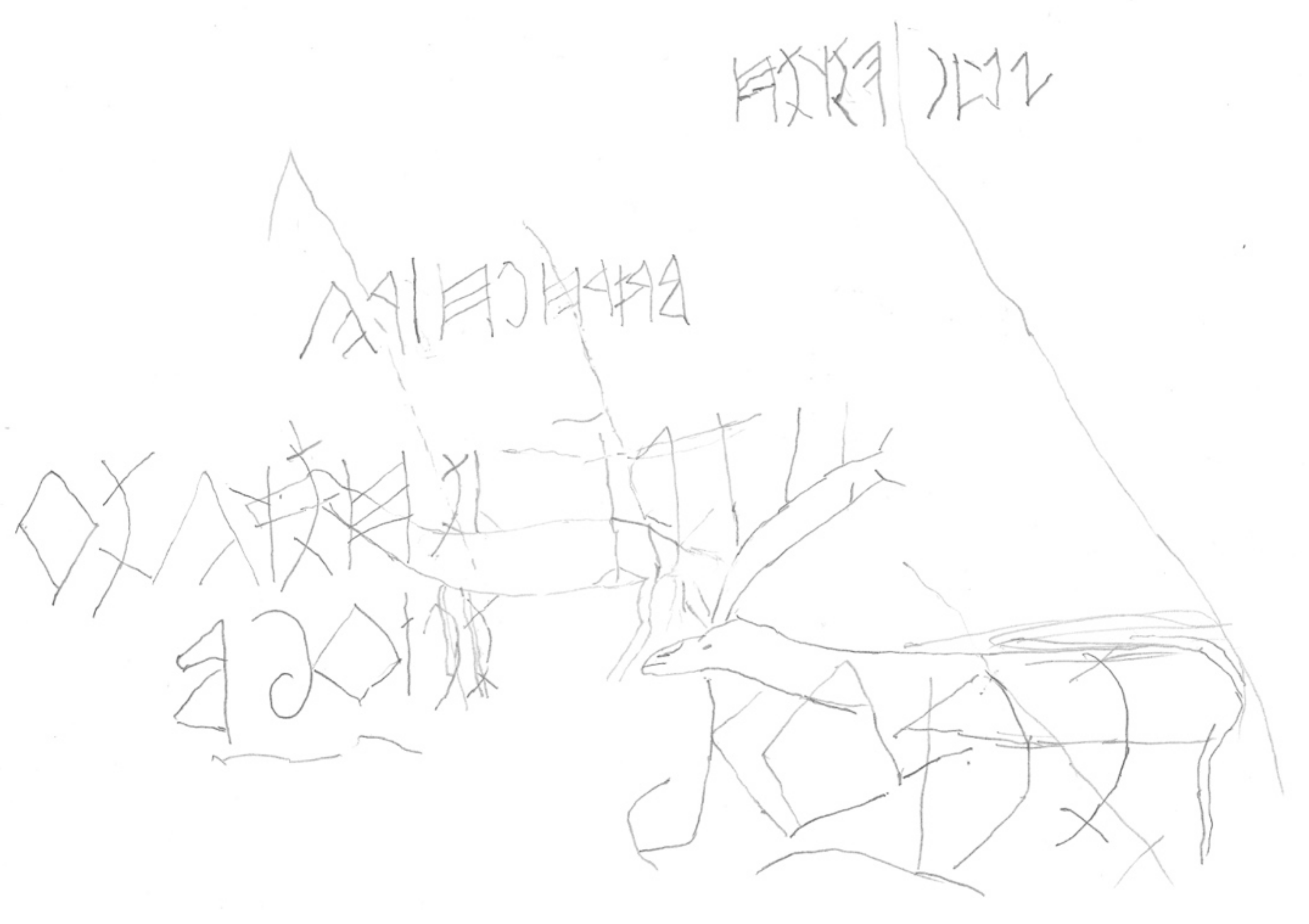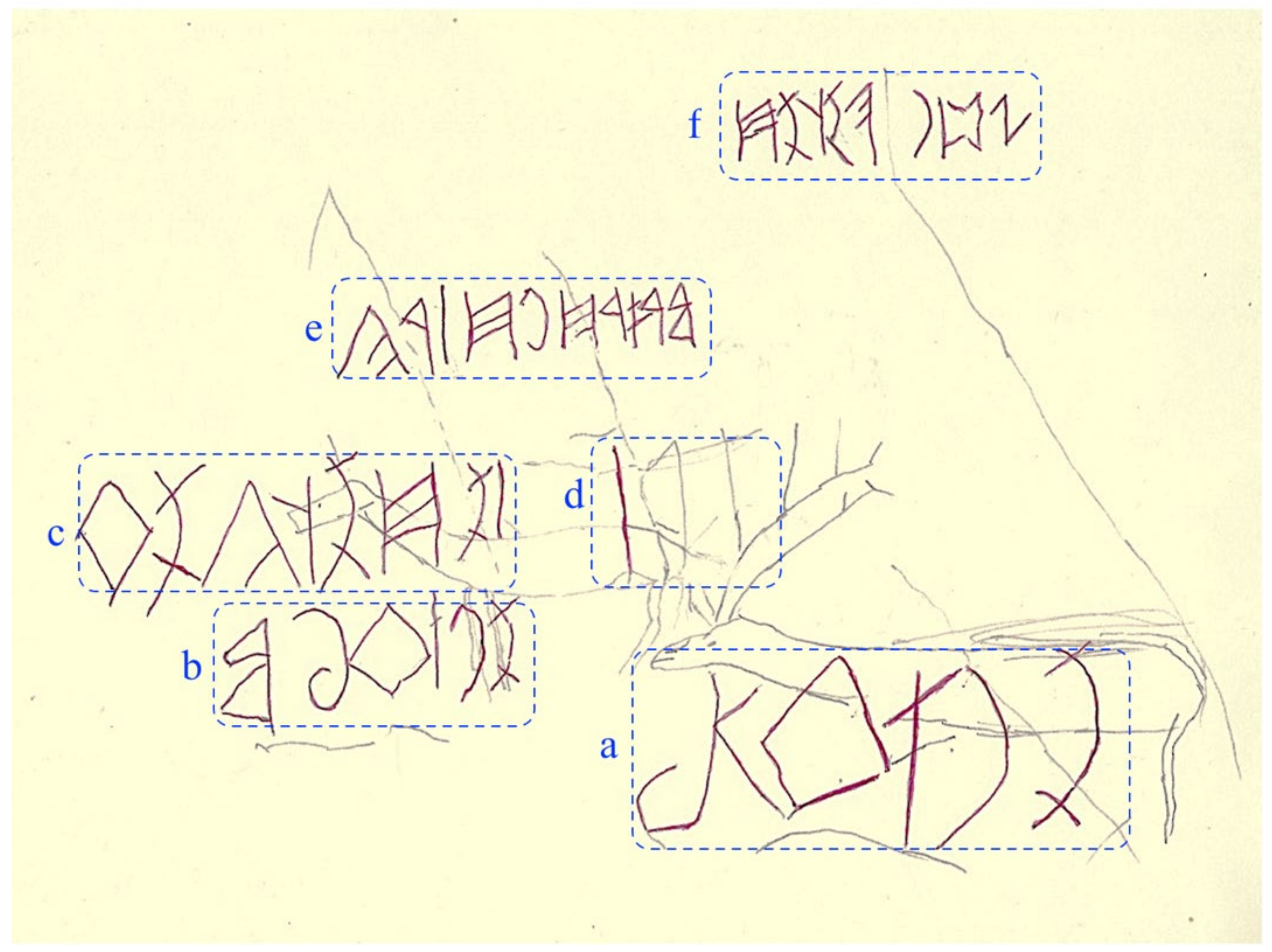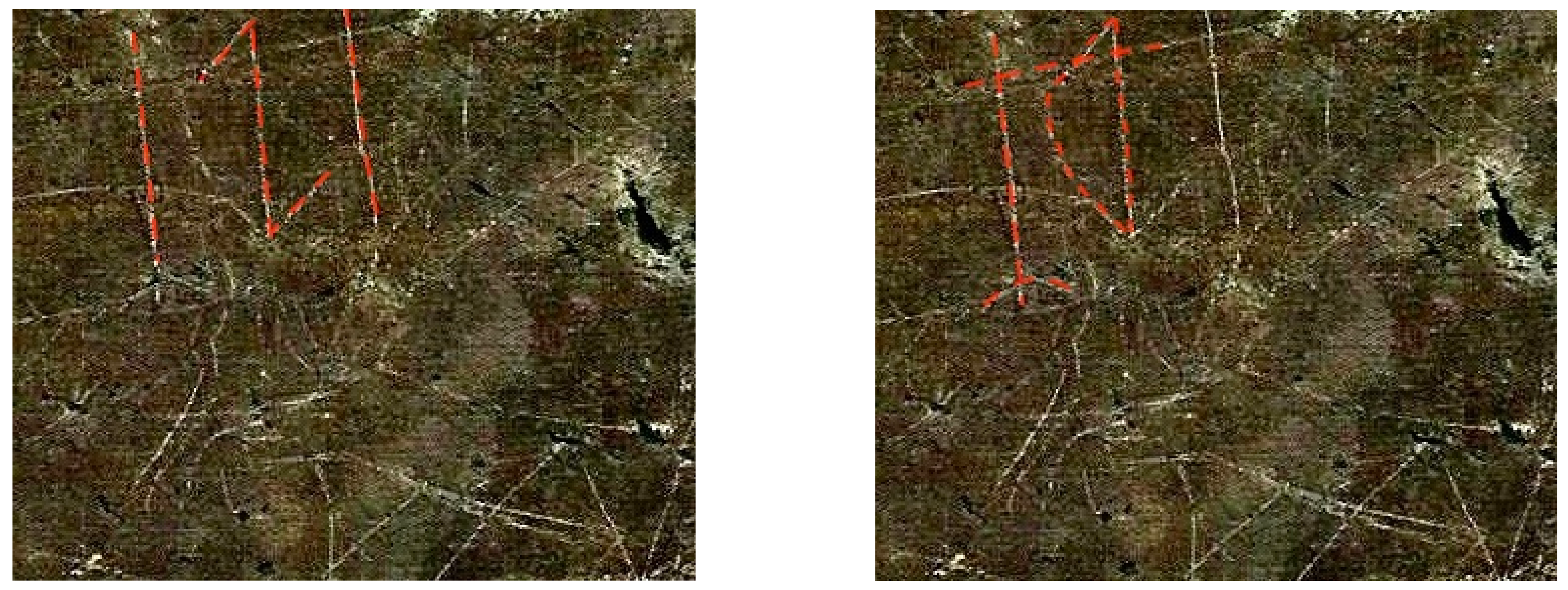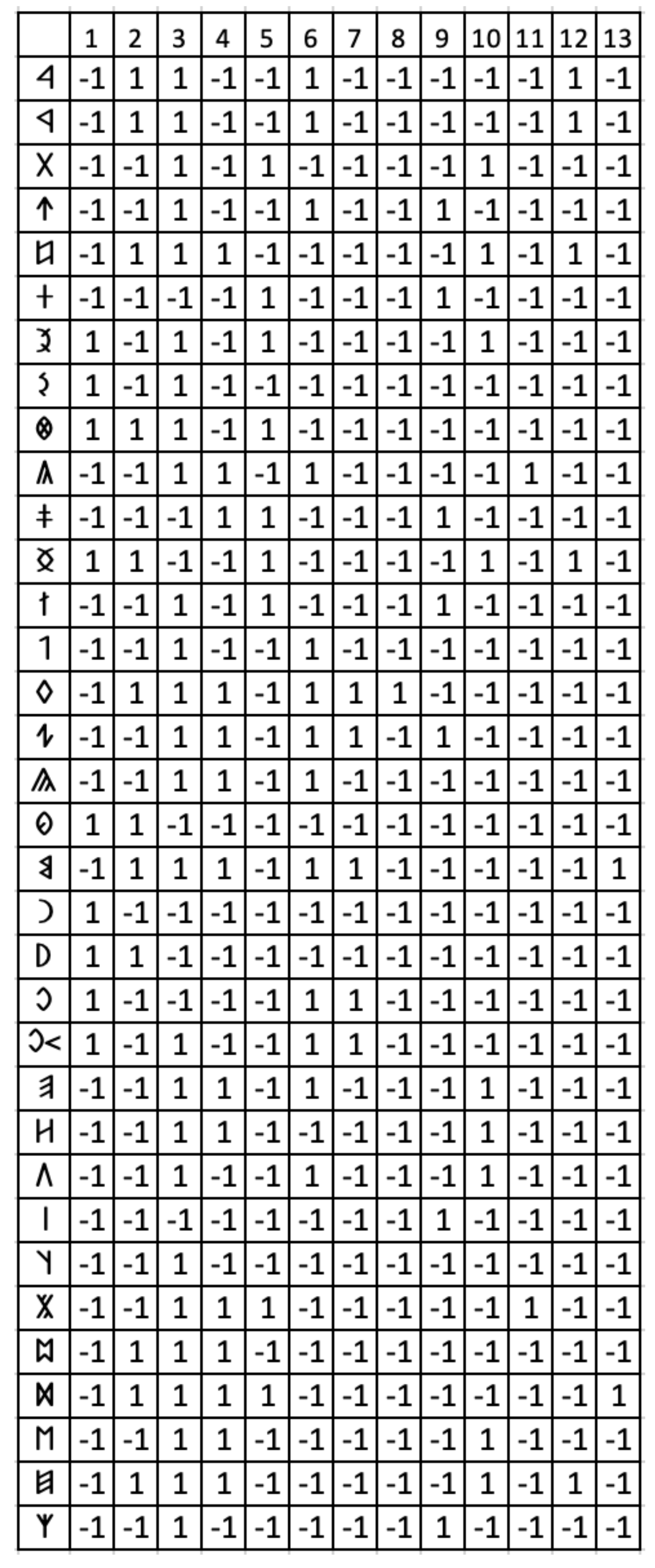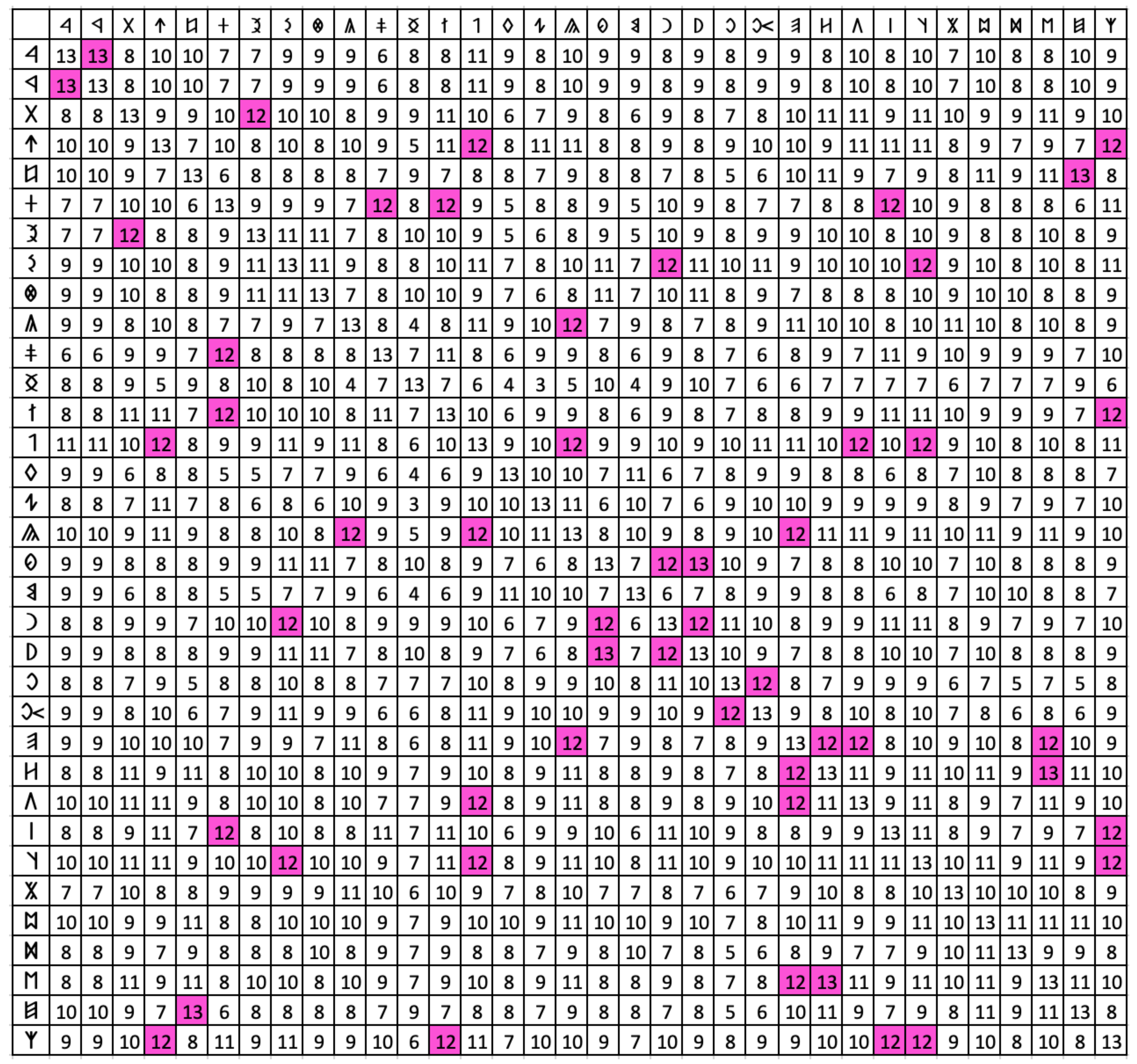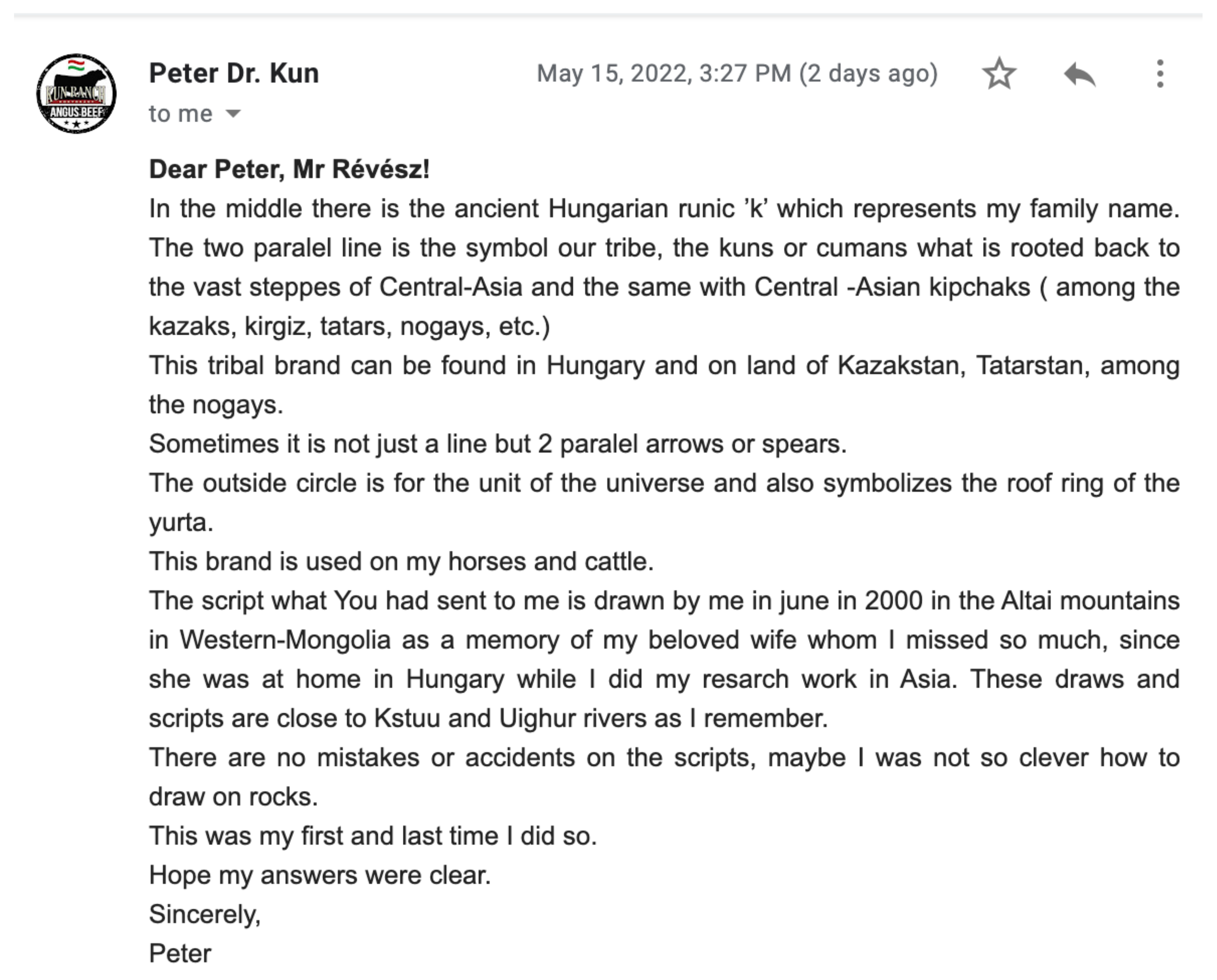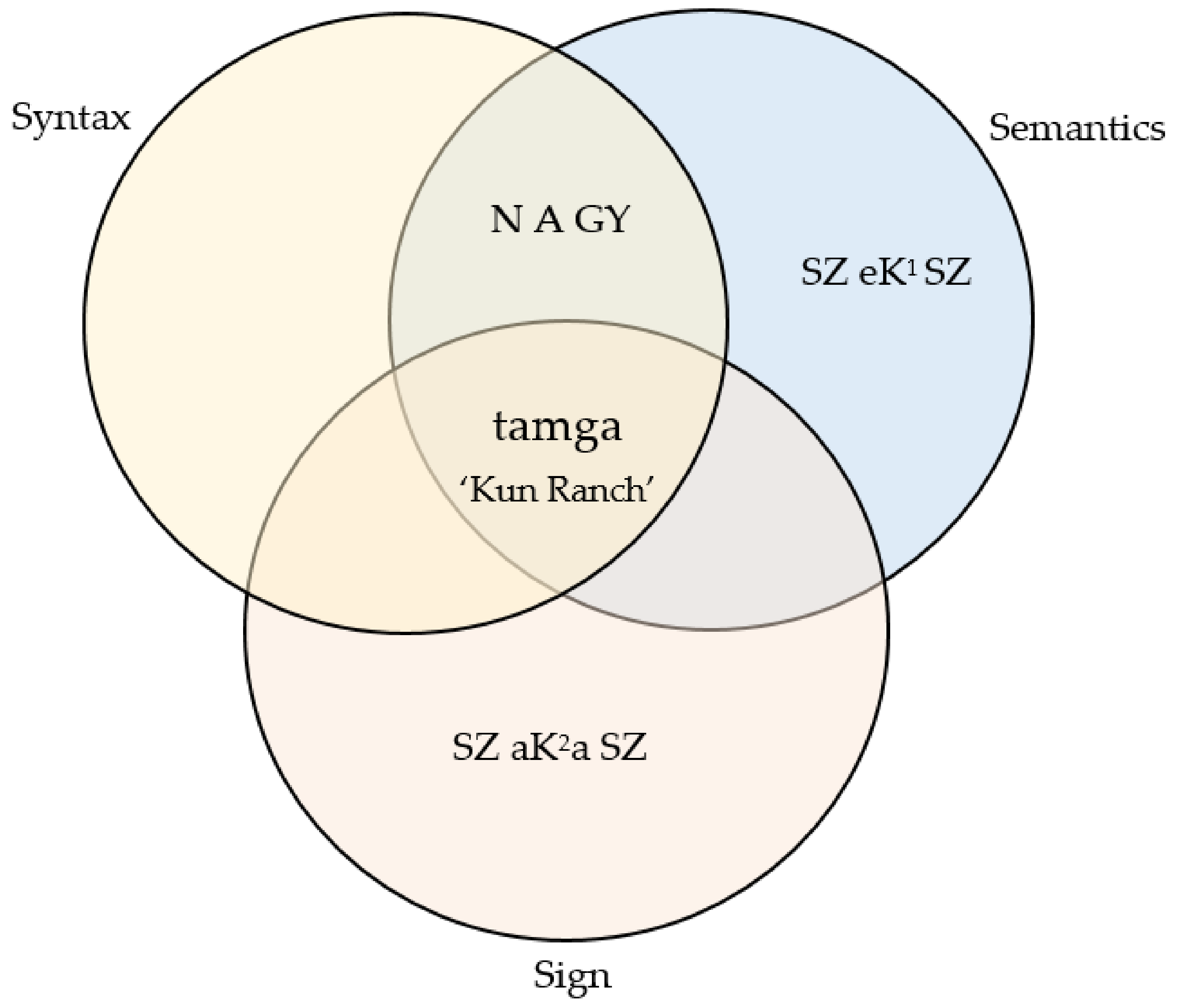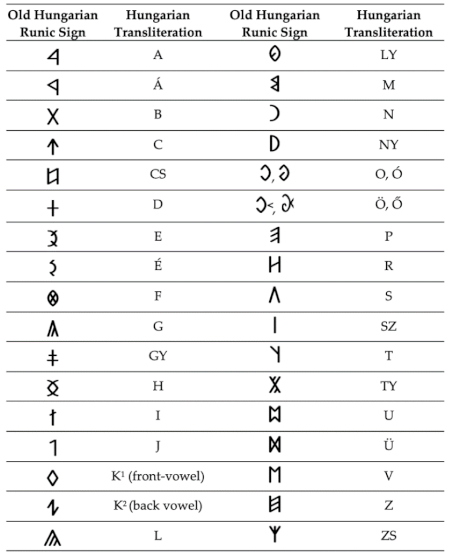4. Transliteration and Correction of the Signs
Since Old Hungarian inscriptions are written from right to left, we first convert the sign groups into a left-to-right order as shown in
Table 2. Next, we also attempted a transliteration to find the meaning of the words.
It is apparent to Hungarian language speakers that some words do not make sense, although they are close to common Hungarian words. For example, in sign group (f), the intended name PÉTER can be easily recognized instead of the nonsense string PÉTEZ. This suggests that the scribe made a spelling mistake. In particular, the scribe wrote the Old Hungarian Z sign instead of the Old Hungarian R sign.
These two signs look similar; hence, it is understandable that such a mistake can be made by someone who is not completely familiar with the script. The Altai Mountain inscription uses a form of Z that has two legs. In many texts, including this paper, the following slightly different form of Z is used:
Apparently, the scribe also mixed up the Old Hungarian signs G and L in the words MAGYARORSZÁG and SZERETLEK. These two signs also look similar.
The incorrect signs and transliterated letters are highlighted in brown in
Table 2. Those signs and letters can be corrected to their intended versions as shown in
Table 3.
The mix-up of the above pairs of Old Hungarian signs is a natural consequence of their similar look. Nevertheless, it is possible to ask why exactly these signs are mixed up in the inscription. To answer that question, we can apply a mathematically based approach to sign similarities. This approach was developed in an earlier paper that compared the Minoan Linear A, the Carian, and the Old Hungarian script [
7]. The approach starts by identifying which sign has which of the following thirteen features:
The symbol contains some curved line.
The symbol encloses some region.
The symbol has a slanted straight line.
The symbol contains parallel lines.
The symbol contains crossing lines.
The symbol’s top is a wedge ∧.
The symbol’s bottom is a wedge ∨.
The symbol’s right side is a wedge >.
The symbol contains a stem, a straight vertical line that runs across the middle.
The symbol’s bottom has two legs, two single lines touching the bottom.
The symbol’s bottom has three legs, three single lines touching the bottom.
The symbol contains a hair, a small line extending from an enclosed space.
The symbol contains two triangles.
Figure 4 shows a matrix that results from a feature analysis of the Old Hungarian Runic signs in terms of the above 13 features.
Figure 5 shows a similarity matrix of the Old Hungarian signs. Each entry shows the number of features on which the row and the column signs agree. Two signs agree on a feature if they both contain the feature or both lack the feature. This means that they both have a value of 1 or they both have a value of −1 for the same feature in the feature table in
Figure 4. We can propose the theorem below.
Theorem 1. Let A be an n × m feature matrix with n signs and m features. Furthermore, let AT be the transpose of A, and let M be the n × n similarity matrix for the n signs. Then, the following formula holds:where C is a matrix in which each entry is m. Proof.
Consider any entry
of the similarity matrix. This entry has the value of
where the dot indicates the dot product of the two vectors. The inner parenthesis in Equation (2) contains the number of times signs
i and
j that either both contain or both lack a feature minus the number of times they disagree on a feature as follows:
Let
agree be the number of times that cases (3) and (4) occur. Let
disagree be the number of times that cases (5) and (6) occur. Then, the following must hold for any number of features
m because the two signs must either agree or disagree on each feature:
Hence, according to the above observation and Equation (7), the inner parenthesis has the following value:
From Equation (8), it can be also seen that
Therefore, the value of is the total number of features on which signs i and j agree as required for the similarity matrix. QED.
Theorem 1 is useful for the fast calculation of the similarity matrix given any feature matrix. Theorem 1 was used to calculate the similarity matrix shown in
Figure 5 from the feature matrix shown in
Figure 4. After the similarity matrix was calculated, the entries with a similarity value of 12 or 13 between two different signs were highlighted in pink as shown in
Figure 5.
The similarity matrix had 34 × 33 = 1122 nondiagonal entries. Out of those, 52 (4.63%) were marked pink. Intuitively, these pairs were those most likely to be confused with each other according to this mathematical model.
At my request, Klara Friedrich, a prominent researcher and teacher of the Old Hungarian Runic script, verified that, in her decades of experience, it is common to mix up the following letters:
![Information 13 00422 i055]()
Among the above, the G–L pair has a similarity of 12, the R–Z and the Z–CS pairs have similarities 11 and 13, respectively, and the D–I pair has a similarity of 12. Hence, these frequently mixed up pairs also have high similarity scores according to the similarity matrix in
Figure 5. Hence, the strong agreement between the mathematical model and the teacher’s experience shows that the G–L and R–Z pair mix-ups in the Old Hungarian Runic inscription in
Figure 1 were likely due to an accident. □
Not everyone agrees with the accidental nature of the letter mix-ups. G. Varga imagined that the inscription had some sexual message. Moreover, he claimed that a male scribe wrote every sign originally correctly, but he later deliberately changed the inscription by adding extra lines for the sake of a woman called
Enikő, who was embarrassed and ‘obviously did not want to make public what happened’. According to Varga, these deliberately added extra lines explain the mix-up of the letters as shown in his figure (
Figure 2 in [
1]). However, this theory runs into a major problem in explaining the incorrect G in the word SZ E
Z E T
G E K
1.
![Information 13 00422 i056]()
Since scratches and carvings cannot be erased from a rock surface like from a paper, one cannot destroy a correct L into an incorrect G because it requires the deletion instead of the addition of a line. Hence, it is an untenable hypothesis that all spelling mistakes were deliberately introduced to destroy the meaning of the writing.
5. Decipherment Requires Correct Signs, Syntax, and Semantics
Valid decipherment requires correct signs, syntax, and semantics. These can be defined as described below.
First, the shapes of the signs are visually recognized correctly. As in the case of the Altai Mountain inscription, shape recognition can be hindered by deficiencies in the visual quality of the object (cracks in the rock, weathering, overwriting the signs by other inscriptions and drawings, etc.) and deficiencies in the photographs available to the investigator. An onsite investigation is almost always preferable to even the best available photograph.
Second, the visually correctly identified sign needs to also be correctly transliterated. It is of no use to correctly discern the shape of a sign, and then incorrectly look up its transliteration. Obviously, that cannot lead to a valid decipherment.
- 2.
Syntax: This means that the words fit together according to the accepted grammatical rules. Moreover, the grammar must match the period of the inscription. For example, one cannot use present day Hungarian language grammar for an inscription from the Middle Ages. Translations that add suffixes purely from the imagination of the decipherer cannot be considered valid, even if the root words look acceptable. Even ancient Sumerian pictographs and cuneiforms reflect a well-formed, complex grammar.
- 3.
Semantics: This means that the sentences and story are meaningful. The meaningfulness of the text needs to be evaluated in terms of the time and other circumstances of writing. For example, there should not be any anachronisms such as talking about dinosaurs in an ancient text because those became extinct long before the first scripts were developed.
In the Altai Mountain inscription, all the sign groups have an unambiguous reading except sign group (d). Now, let us evaluate the proposal (d2), which is equivalent to the word NAGY. If we read the sign groups in order from bottom up as shown in
Figure 2, then we obtain the following Hungarian sentence:
E N I K1 Ő, E N I K1 Ő M, SZ E R E T L E K1.
N A GY- M A GY A R O R SZ Á G, K2 U N P É T E R.
Here, the Hungarian compound word Nagy-Magyarország ‘Greater Hungary’ refers to the historical Hungary, which includes present day Hungary and territories in neighboring countries where Hungarians live as minorities. It is necessary to add as an explanation that a literary reference to Nagy-Magyarország does not mean territorial aspirations but is only a reference to the international Hungarian ethnic community to which many minority Hungarians feel they belong. Hence, the inscription can be translated as a grammatically and semantically correct message as follows:
I love you Enikő, my Enikő!
--Peter Kun, Greater Hungary.
Now, let us consider the proposal (d1), which was SZ K
2 SZ. One can immediately see that this proposal has a weakness because this is not a meaningful word. It lacks vowels. In the older, mostly medieval examples of Old Hungarian Runic inscriptions, the vowels were often omitted when they did not affect the readability of the text. However, this is clearly not a medieval text. Some orthographic considerations regarding the form of the Old Hungarian signs support this assertion, but we can skip those considerations because there is a simpler explanation of recentness, i.e., that the name
Enikő was created by the poet Vörösmarty (1800–1855) [
9]. That linguistic consideration alone helps date the text to after the latter half of the 19th century. Hence, we need to consider a period when the omission of vowels was no longer practiced. This period includes a considerable revival of interest in the Old Hungarian Runic script in the past 30 years.
It is unlikely that the scribe wrote down each vowel in every other word except in SZ K2 SZ. However, let us entertain this idea by trying to find a word. Since K2 requires a back-vowel, a word that may be found is SZaK2aSZ or szakasz (International Phonetic Alphabet notation:/sakas/) with the meaning ‘segment’. However, this lacks correct semantics because the phrase SZeReTLeK1 SZaK2aSZ ‘I love you segment’ makes no sense.
Mr. Varga suggested the Hungarian word szex (International Phonetic Alphabet notation:/seks/) with the meaning ‘sex’. Since letter X does not occur in the Old Hungarian Runic script, words with X are written down by a K SZ combination. Hence, let us try to write down the word as SZeK2SZ. That would violate the second condition of sign correctness because one needs to transliterate K2 as a consonant that occurs with a back-vowel, while e is a front-vowel.
The argument can be made that the scribe forgot about the differences between K1 and K2. However, it is unlikely because everywhere else the scribe uses these two signs correctly, as can be easily checked.
Front-vowel words: E N I K1 Ő, E N I K1 Ő M, SZ E R E T L E K1.
Back-vowel word: K2 U N.
Apparently, the scribe is consistent in the use of K1 and K2, and there is no real logic of supposing that they made a mistake just here regarding this usage convention, as well as making a mistake just here regarding explicitly writing down the vowel just in this word. Moreover, SZeK2SZ is grammatically incorrect. A grammatically correct phrase would be the following:
E N I K1 Ő, E N I K1 Ő M, SZeK2SZ-uálisan SZ E R E T L E K1,
which means
I love you sexually Enikő, my Enikő.
However, the suffix -uálisan is completely absent. Hence, the SZeK2SZ word proposal is semantically correct, but it is incorrect in signs and syntax. Despite the above concerns, this proposal of my coauthor was kept as an alternative together with my NAGY word proposal. Unfortunately, we omitted to mention that sign group (d) may be a personal sign or tamga, although Varga added the following endnote to his blog entry of 16 March 2022. The top shows a screenshot of the original Hungarian text, with an English translation in italics below.
(3) The word’s reading as ‘sex’ is supported by the fact that it explains why Peter Kun tried to destroy the readability of the inscription. If this were a tamga, as Peter Revesz once mentioned, then this deliberate destruction would be unexplained.
6. Identification of Sign Group (d) as a Tamga
A
tamga is an emblem of a family, clan, or tribe. Tamgas were widely used by Eurasian nomads as a mark of personal property such as in branding livestock. For example, the early Bulgarian ruling dynasty, the Dulo clan, used the tamga shown in
Figure 6a. For example, this tamga was found on the back of a seventh to ninth century bronze rosette at Pliska, Bulgaria [
10] and on a ninth century clay pot fragment at Zalavár, Hungary [
11]. The Kayi was one of the 21 Oghuz Turkic tribes. The Kayi tamga is shown in
Figure 6b.
Thanks to the publicity of our publication [
1], as a wonderful crowdsourcing effort, many people sent me various tips about who Peter Kun may be. When I got a tip about his phone number, I called him, and he verified that he was the scribe of the Altai Mountain inscription. I followed up our conversation with an email in which I asked some detailed questions. In his reply, which is shown in
Figure 7, he explains that sign group (d) is a tamga. The middle K
2 sign stands for his family name, Kun, which has a back vowel. Hence, K
2 is used instead of K
1, which would be appropriate for a name with a front-vowel.
The two parallel signs on the left and right sides of the tamga are symbols of the Cumans, an ancient steppe people, whose domain extended from Hungary to Mongolia ca. 1200. Sometimes, the parallel lines are replaced by two arrows or spears. The three tamgas of
Figure 6 all have two vertical parallel lines on the left and right sides. They differ only in the middle letter that is enclosed between those two parallel lines. These letters are Y-shaped for the Dulo clan, V-shaped for the Kayi tribe, and Z-shaped for Peter Kun. These three tamgas can be classified as members of the same subgroup of Turkic tamgas.
Peter Kun created this tamga for his own use in honor of his Cuman ancestors, who settled in a part of Hungary that is named after them to this day. It is called Kunság in Hungarian. The Cuman descendants in Hungary have their own organization, and Peter Kun serves as a leader in that organization. Peter Kun is also a cattle rancher and uses the tamga as a branding sign for his cattle.
Peter Kun verified that he did not make any deliberate alterations of the signs. He also explained that he was longing for
Enikő, his wife, who was left behind in Hungary, while he was traveling in the Altai Mountains and doing research. He has a doctorate in Turkic studies. He even published a book about his research travels in Asia during which he studied the equestrian culture of the Steppe nomads [
12].
Hence, the entire inscription can be seen as follows:
E N I K1 Ő, E N I K1 Ő M, SZ E R E T L E K1.
![Information 13 00422 i058]()
, M A GY A R O R SZ Á G, K
2 U N P É T E R.
The tamga is not transliterated because it is a personal property symbol or emblem that can stand for ‘Kun Ranch’. Hence, the correct translation into English is the following:
I love you Enikő, my Enikő!
--Peter Kun, Kun Ranch, Hungary.





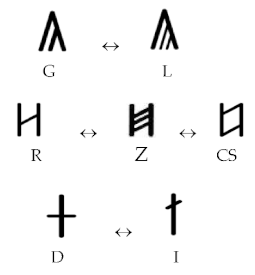


 , M A GY A R O R SZ Á G, K2 U N P É T E R.
, M A GY A R O R SZ Á G, K2 U N P É T E R.